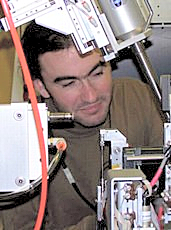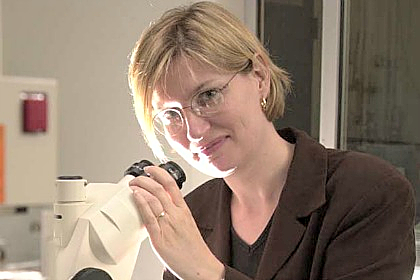Cell genomes are under constant attack, incurring DNA damage requiring an array of repair mechanisms to keep cells healthy and vital. DNA polymerases are enzymes that create DNA molecules by assembling nucleotides, which are the building blocks of DNA — enzymes essential to DNA replication that usually work in pairs in order to create two identical DNA strands from a single original DNA molecule. During this process, DNA polymerase reads existing DNA strands to create two new strands that match the existing ones.
Understanding the behavior of enzymes that defend cells against assault helps in determining how and where cancer gets a foothold and flourishes. New research by scientists at the University of Vermont, and published online 16 March 2015 in advance of print by the journal Nature Structural & Molecular Biology, shows that one DNA polymerase enzyme — human DNA polymerase theta (POLQ) — may be hold promise as a drug therapy target for combating breast cancer.
The paper, entitled “Human DNA polymerase grasps the primer terminus to mediate DNA repair“ (Nature Structural & Molecular Biology (2015) doi:10.1038/nsmb.2993), is coauthored by Karl E. Zahn, April M. Averill, and Sylvie Doublié of the University of Vermont Department of Microbiology and Molecular Genetics at Burlington, Vermont, Pierre Aller of Diamond Light Source in Didcot, Oxfordshire, UK, and Richard D. Wood of the Department of the Epigenetics & Molecular Carcinogenesis department at the University of Texas MD Anderson Cancer Center in Smithville, Texas.
[adrotate group=”3″]
The researchers note that every time a cell divides, DNA polymerase is required to help duplicate the cell’s DNA, in order for a copy of the original DNA molecule to be passed to each of the daughter cells, transmitting genetic information from generation to generation. However, before such replication can happen, an enabling enzyme called helicase unwinds the DNA molecule from its tightly woven form, which opens up the double-stranded DNA to yield two single DNA strands of that can be used as replication templates.
 “The human genome encodes more than 15 different polymerases, which are the essential enzymes that copy our genetic material,” observes Karl Zahn, Ph.D., a University of Vermont postdoctoral associate and first author on the study. Dr. Zahn worked several years in the Doublié lab at the University of Vermont, where he crystallized complexes of the DNA polymerase from phage RB69 with DNA and nucleotides. Currently, he is investigating the mechanisms of translesion DNA synthesis by both replicative and repair DNA polymerases — processes that are inherently error-prone and precede mutation and cancer.
“The human genome encodes more than 15 different polymerases, which are the essential enzymes that copy our genetic material,” observes Karl Zahn, Ph.D., a University of Vermont postdoctoral associate and first author on the study. Dr. Zahn worked several years in the Doublié lab at the University of Vermont, where he crystallized complexes of the DNA polymerase from phage RB69 with DNA and nucleotides. Currently, he is investigating the mechanisms of translesion DNA synthesis by both replicative and repair DNA polymerases — processes that are inherently error-prone and precede mutation and cancer.
DNA polymerase (POLQ) is a low-fidelity DNA polymerase that belongs to the family A polymerases and is believed to protect against genomic instability via an alternative end-joining repair pathway for DNA double-strand breaks. Polymerase is overexpressed in breast, lung and oral cancers, and reduction of its activity in mammalian cells increases sensitivity to double-strand break inducing agents, including ionizing radiation.
A University of Vermont release notes that POLQ is known to serve a specialized role, and is capable of performing some tasks that other polymerases are unable to do, including repair of certain toxic double-strand breaks in the DNA, which can induce genomic instability if left unprepared, and whose instability can sometimes lead to cancer, especially the types of cancer that are most difficult to treat.
Already found in breast, ovarian, lung and oral cancers, POLQ is believed to play a role in a number of additional cancers, making the impact of the University of Vermont group’s finding potentially far-reaching with respect to new therapies.
Using X-ray crystallography, Dr. Zahn, University of Vermont professor of microbiology and molecular genetics Sylvie Doublié, Ph.D., and colleagues, determined the first crystal structures of POLQ — recently highlighted as the only DNA polymerase overexpressed in certain breast and ovarian cancers providing a visual of the DNA repair process.

“The field focused on this enzyme is evolving,” says Dr. Doublié, senior author on the Nature Structural & Molecular Biology paper — one of several POLQ-related studies published recently. The UV team’s work constitutes a first step in determining how POLQ can be feasibly pursued as a cancer drug target. “Having this new structure really helps inform this process,” Dr. Doublié observes.
 Drs. Doublié and Zahn’s paper coauthor Richard Wood, Ph.D. , Grady F. Saunders Distinguished Professor in Molecular Biology in the Department of Epigenetics & Molecular Carcinogenesis of the The University of Texas MD Anderson Cancer at Smithville, Texas, and research team colleagues, are now in the process of examining candidate drug-like molecules that might possibly act specifically on POLQ without inhibiting other necessary polymerases in order to limit cancer treatment side effects.
Drs. Doublié and Zahn’s paper coauthor Richard Wood, Ph.D. , Grady F. Saunders Distinguished Professor in Molecular Biology in the Department of Epigenetics & Molecular Carcinogenesis of the The University of Texas MD Anderson Cancer at Smithville, Texas, and research team colleagues, are now in the process of examining candidate drug-like molecules that might possibly act specifically on POLQ without inhibiting other necessary polymerases in order to limit cancer treatment side effects.
Dr. Wood explains on his MD Anderson Center Website:
“Many enzymes and regulatory proteins are devoted to the repair of DNA damage arising from agents inside cells and from the environment. DNA repair is a front-line defense against the mutations that can accumulate to cause cancer. Research in my laboratory includes exploration of the biochemical mechanism of the DNA nucleotide excision repair pathway in human cells. We have reconstituted the process with purified proteins and can dissect intermediates in the reaction. In one study we are examining how this repair process participates in resolving cross-links between DNA strands. We also investigate several DNA polymerases that help cells tolerate DNA damage. Some of the work is with a mouse model deficient in DNA polymerase zeta, to understand the role of this enzyme in chromosome instability, skin carcinogenesis and mammary carcinogenesis. In addition, we are determining the biochemical and cellular functions of two other specialized DNA polymerases which were identified in our laboratory, POLQ and POLN. These are nuclear enzymes present only in higher eukaryotes and both have an unusual ability to bypass specific lesions in DNA templates. This research will provide insights into how DNA damage is tolerated in cells before it is repaired.”
In addition to Dr. Doublié, a professor of microbiology and molecular genetics, Dr. Zahn, and Dr. Wood, study coauthors include University of Vermont senior research technician in microbiology and molecular genetics April Averill, and Pierre Aller, Ph.D., of Diamond Light Source, Didcot, Oxfordshire, UK.
Dr. Doublié, who was named a 2014-15 University Scholar, will present her University Scholar lecture on “Protein-DNA Interactions Made Crystal Clear” on April 15, 2015, from 4:00 to 5:00 p.m. in the University of Vermont Memorial Lounge (Rm. 338) in the Waterman Building.
The study was supported with funding from the National Institutes of Health (R01 CA052040 and CA097175), a grant from the Cancer Prevention and Research Institute of Texas (RP130297) and the Grady F. Saunders PhD. Distinguished Research Professorship. The GM/CA beamline at the Advanced Photon Source has been funded in whole or in part with federal funds from the National Cancer Institute (ACB-12002) and the National Institute of General Medical Sciences (AGM-12006). This research used resources of the Advanced Photon Source, a U.S. Department of Energy (DOE) Office of Science User Facility operated for the U.S. DOE Office of Science by Argonne National Laboratory under contract no. DE-AC02-06CH11357.
Sources:
University Of Vermont
Nature Structural & Molecular Biology
University of Texas MD Anderson Cancer
Wikipedia
Image Credits:
University Of Vermont
University of Texas MD Anderson Cancer
COM Design & Photography
